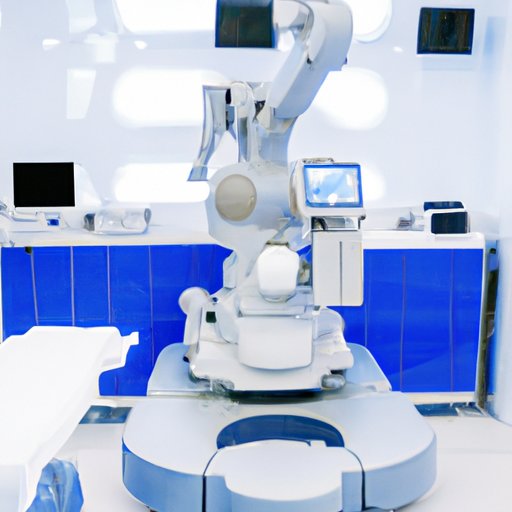Introduction
Medical robotics is a rapidly growing field that has revolutionized the way healthcare is delivered to patients. The term “medical robotics” refers to the use of robotic technology in healthcare for the purpose of performing surgery, diagnostics, and physical therapy. This article will explore the various applications of medical robotics, its potential benefits and impact, and the future of this technology in healthcare.

Exploring the Use of Medical Robots in Surgery
Medical robots are increasingly being used in minimally invasive surgeries such as laparoscopic and thoracoscopic procedures. According to a study published in the International Journal of Surgery, “Robotic surgery offers greater precision and dexterity than traditional laparoscopy and may be associated with decreased postoperative pain and shorter recovery times.”
The use of medical robots in surgery provides several benefits, including improved accuracy, precision, and maneuverability. The robot’s arms are equipped with miniature cameras, enabling surgeons to get a close view of the procedure site, as well as providing three-dimensional images and magnified views of the area. This enables surgeons to perform more precise and delicate operations, leading to better patient outcomes.
Robotic surgery is also less invasive than traditional open surgery, resulting in fewer complications, faster healing times, and reduced hospital stays. In addition, robotic surgery offers greater visualization of the operating site and enhanced control over the instruments, allowing for more complex and precise movements.
Types of surgeries performed with medical robots include laparoscopic cholecystectomy (gallbladder removal), hysterectomy (removal of the uterus), prostatectomy (prostate removal), and hernia repair. Robotic-assisted surgeries are also being used to treat cancer, heart disease, and neurological disorders.

Examining the Benefits of Using Medical Robots for Diagnostic Procedures
Medical robots are also being used for diagnostic purposes. These robots can provide accurate and precise readings of vital signs such as heart rate, blood pressure, and body temperature. They can also detect abnormalities in tissue samples and provide detailed images of the interior of the body.
The use of medical robots for diagnosis has allowed for improved accuracy and precision when diagnosing diseases and conditions. For example, robots equipped with artificial intelligence (AI) algorithms can analyze thousands of data points from medical images and identify subtle abnormalities that may not be visible to the naked eye. This can lead to more accurate and timely diagnoses, resulting in improved patient outcomes.
Investigating How Medical Robotics Is Revolutionizing Healthcare
The use of medical robots is revolutionizing healthcare by increasing efficiency and cost savings. Robots can automate routine tasks such as drawing blood or dispensing medications, freeing up clinicians’ time to focus on patient care. This can result in shorter wait times, increased patient satisfaction, and improved clinical outcomes.
In addition, medical robots can reduce human error by eliminating manual tasks such as administering medications or taking vital signs. This can lead to improved patient safety and reduced healthcare costs.

Understanding the Role of Medical Robots in Physical Therapy
Medical robots are also being used in physical therapy to improve the rehabilitation process. Robots can be programmed to perform precise motions and exercises, allowing physical therapists to customize treatment plans for each patient. This can lead to improved outcomes and increased patient satisfaction.
Robots can also be used to deliver treatments such as electrical stimulation, ultrasound, or heat therapy. This can help speed up the rehabilitation process and reduce the need for manual labor on the part of the physical therapist.
Analyzing the Impact of Medical Robots on Hospital Efficiency
The use of medical robots can also lead to improved hospital efficiency. Robots can automate mundane tasks such as cleaning and disinfecting rooms, freeing up clinicians’ time to focus on patient care. This can lead to shorter wait times, increased patient satisfaction, and improved clinical outcomes.
Robots can also streamline workflows by automating administrative tasks such as scheduling appointments or filing paperwork. This can reduce human errors and improve communication between departments, resulting in a more efficient hospital environment.
Evaluating the Cost-Effectiveness of Medical Robots
The cost of medical robots can be a major factor in determining whether or not to invest in this technology. While the initial investment cost can be high, there are long-term cost savings associated with using medical robots. For example, robots can automate mundane tasks such as cleaning and disinfecting rooms, reducing the need for human labor. This can lead to lower labor costs and improved efficiency, resulting in overall cost savings.
In addition, medical robots can reduce human error and provide more accurate results, leading to improved patient outcomes and reduced healthcare costs.
Looking at the Future of Medical Robotics and Its Potential Uses
The future of medical robotics is bright, with new technologies and applications being developed every day. For example, robots are being used to assist with telemedicine, allowing clinicians to remotely diagnose and monitor patients. In addition, robots are being used to perform remote surgery, allowing surgeons to operate on patients from anywhere in the world.
Robots are also being used for drug delivery, allowing for more precise and targeted delivery of medications. This can improve the efficacy of treatments and reduce adverse side effects.
Conclusion
Medical robotics is a rapidly growing field with the potential to revolutionize healthcare. This article has explored the use of medical robots in surgery, diagnostics, physical therapy, and other areas of healthcare. It has examined the potential benefits of using medical robots, such as improved accuracy, precision, and patient outcomes, as well as its impact on hospital efficiency and cost-effectiveness. Finally, it has looked at the future of medical robotics and its potential uses, such as remote surgery and drug delivery. As the technology continues to evolve, it is clear that medical robotics will continue to play an important role in the future of healthcare.
(Note: Is this article not meeting your expectations? Do you have knowledge or insights to share? Unlock new opportunities and expand your reach by joining our authors team. Click Registration to join us and share your expertise with our readers.)
